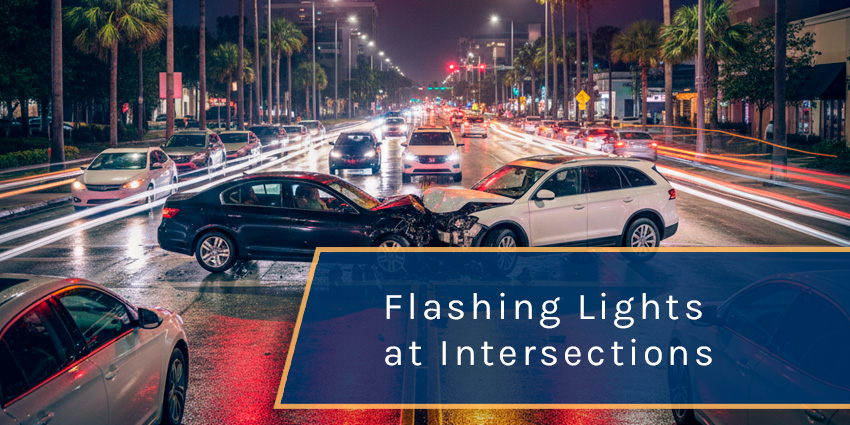Florida car accidents at intersections with flashing lights are a significant safety challenge that requires drivers to be aware and respond correctly. These intersections often become accident hotspots when drivers misunderstand signals or fail to follow established rules.
Under Florida Statute 316.075, these signals carry specific legal obligations. Violations result in traffic citations and potential liability in accident cases. Knowing these Florida traffic laws can help prevent accidents and protect you from becoming a car accident victim.
Table of Contents
Key Traffic Signals and How to Prevent Florida Car Accidents
Flashing Red Light
A flashing red light works just like a stop sign according to Florida traffic laws. Drivers must come to a complete stop before the stop line or crosswalk, then yield the right-of-way to all pedestrians and vehicles already in the intersection. You may proceed only when the intersection is clear and safe. Treating a flashing red light as anything less than a full stop constitutes a traffic violation and significantly increases accident risk.
Flashing Yellow Light
A flashing yellow light requires you to be extra careful but does not mean you have to stop completely. Slow down and be ready to give way to pedestrians, oncoming traffic, or vehicles that have the right-of-way. This signal warns you about possible dangers or unusual traffic situations ahead. If you speed through these signals without paying attention, you are creating dangerous conditions for yourself and others.
Flashing Yellow Arrow
A flashing yellow arrow specifically controls turning movements. You may turn after giving way to oncoming traffic and pedestrians in the crosswalk. Many intersections are replacing the traditional solid yellow arrow with this signal to allow more flexibility while still ensuring safety requirements.
Flashing Green Light Malfunction
When there is a malfunction with the traffic signal system, it will show a flashing green light. Although it is rare in Florida, you should treat this situation as a four-way stop intersection. All vehicles approaching the intersection must follow the standard right-of-way rules.
Right-of-Way Rules at Intersections with Flashing Lights in Florida Car Accidents
Right-of-way rules at intersections in Florida become critical when flashing signals create uncertainty among drivers. When traffic signals malfunction or flash, for example during a power outage, Florida law establishes clear protocols to prevent confusion and accidents.
Four-Way Stop Protocols
Four-way stop rules apply when all signals flash red or completely malfunction. The first vehicle to arrive at the intersection gains right-of-way. When multiple vehicles arrive simultaneously, the driver on the right proceeds first. Left-turning vehicles must yield to oncoming traffic, even when they arrived first at the intersection.
Pedestrian Priority Requirements
Florida’s yielding to pedestrians laws remain unchanged at flashing intersections. Pedestrians crossing marked crosswalks or unmarked crosswalks, which are areas at intersections between sidewalk or curb extensions even without painted lines, have the right-of-way regardless of signal status. However, pedestrians must exercise reasonable caution as well.
Emergency Vehicle Obligations
Florida law requires drivers to yield immediately to emergency vehicles. All drivers must pull to the right and stop when emergency vehicles approach with activated lights and sirens. This obligation supersedes all other right-of-way considerations at flashing intersections.
Common Driver Mistakes Leading to Florida Car Accidents at Flashing Light Intersections
Navigating intersections with flashing signals can be challenging. Even small mistakes can quickly lead to accidents if drivers aren’t paying full attention. Here are some common driver errors that often occur at these intersections in Florida:
-
Incomplete Stops at Flashing Red Lights: Rolling through flashing red lights instead of stopping can cause collisions, as perpendicular traffic may assume you stopped.
-
Speeding Through Yellow Lights: Accelerating through flashing yellow lights reduces reaction time for pedestrians or turning vehicles, creating dangerous situations.
-
Distracted Driving: Using phones, adjusting navigation, or talking with passengers diverts attention, increasing the risk of missing signal changes or misjudging the intersection.
-
Lack of Driver Precautions: Failing to eliminate distractions and follow traffic control protocols increases accident risk. Conscious attention, situational awareness, and adherence to proper procedures help prevent collisions at these critical intersections.
By staying alert, following proper signal protocols, and taking precautions, drivers can significantly reduce the risk of Florida car accidents at these complex intersections.
Safety Tips for Navigating Intersections with Flashing Lights to Prevent Florida Car Accidents
1. Reduce Speed Immediately
Safety Tip: Slow down as you approach any intersection with flashing lights or signs indicating equipment failure.
Why? This gives you extra time to watch the traffic and spot any potential dangers. Remember, in Florida, when you see flashing lights, it means something unusual is happening with the traffic. Be extra careful.
2. Establish Visual Communication
Defensive Driving Tip: Before entering the intersection, make eye contact with other drivers to ensure they see you.
How? Use your turn signals or hand signals to clearly show what you’re planning to do. This defensive driving tip is especially important when the traffic lights aren’t working properly and everyone has to figure out their own way through.
3. Maintain Extended Following Distances
Situational Awareness Driving Tip: Keep a safe distance between your vehicle and the one in front of you, so you have enough time to stop if needed.
Why? This is even more crucial during bad weather conditions like rain or fog when visibility is low. Stay alert and pay attention to how other vehicles are moving around you.
4. Eliminate All Distractions
Distraction-Free Driving Tip: Put away your phone and any other distractions while driving.
Why? At complex intersections where quick decisions are necessary for safety, it’s vital to focus solely on driving. Your brain can’t effectively handle multiple sources of information at once.
5. Use Turn Signals Consistently
Florida Driving Law Reminder: Always use your turn signals according to the state’s driving laws.
Why? Signaling properly helps other drivers predict what you’re going to do, which reduces the chances of collisions when traffic signals are not functioning as they should be. Clear communication prevents misunderstandings about each driver’s intentions at these potentially dangerous spots.
Handling Traffic Signal Malfunctions and Power Outages Safely to Avoid Florida Car Accidents
Traffic signal malfunctions present significant hazards that require immediate driver adaptation. Florida law mandates treating any completely out or malfunctioning traffic signal as a four-way stop intersection, regardless of the intersection’s normal configuration.
Steps to Take After a Car Accident in Florida at an Intersection with Flashing Lights
Immediate Safety Actions After a Florida Car Accident
Move your vehicle out of traffic lanes if possible and safe to do so. Turn on hazard lights to alert approaching drivers. Check yourself and all passengers for injuries, then assess the condition of occupants in other vehicles involved in the accident.
Emergency Response Protocol
Call 911 immediately to request medical assistance and police response. Emergency services must document intersection crashes, particularly those involving flashing signals. Provide the dispatcher with your exact location, number of vehicles involved, and any visible injuries requiring immediate attention.
Critical Documentation Requirements
Capture comprehensive photographic evidence of:
- Vehicle damage from multiple angles
- Signal status (flashing red, yellow, or malfunctioning)
- Road conditions and weather
- Intersection layout and traffic control devices
- License plates and driver information
Collect witness contact information and statements while memories remain fresh. Record the time, date, and specific circumstances leading to the collision. This documentation proves essential for personal injury claims in Florida car accidents and establishing liability when pursuing compensation.
FAQs (Frequently Asked Questions)
What do flashing red and yellow lights mean at intersections in Florida?
In Florida, a flashing red light requires drivers to come to a complete stop and yield the right-of-way before proceeding, similar to a stop sign. A flashing yellow light signals caution; drivers should slow down and yield if necessary before continuing through the intersection.
How should drivers handle traffic signal malfunctions at intersections in Florida?
Florida law requires treating any completely out or malfunctioning traffic signal as a four-way stop intersection. Drivers must follow established right-of-way protocols, exercise extra caution with temporary flashing signals, and remain vigilant for other road users to avoid accidents.
What are common driver mistakes that lead to car accidents at intersections with flashing lights in Florida?
Frequent errors include rolling through flashing red lights without stopping, speeding through flashing yellow lights without proper caution or yielding, and distracted driving near intersections with complex or malfunctioning signals.
What safety tips can help prevent car accidents at intersections with flashing lights in Florida?
Slow down at intersections with flashing signals, make eye contact, use turn signals, keep a safe distance, be ready to brake, and avoid distractions.
What steps should be taken immediately after a car accident occurs at an intersection with flashing lights in Florida?
If safe, move vehicles out of traffic, check for injuries, call 911, and document the scene with photos and witness information. Then contact an experienced Florida car accident attorney to help with claims and recover compensation.
Florida Car Accidents Victims: Why You Should Hire a Florida Personal Injury Attorney
Intersection accidents involving flashing lights create complex legal scenarios requiring specialized expertise. Florida personal injury attorneys with experience handling Florida car accidents excel at navigating the complexities surrounding traffic signal malfunctions and driver errors. They build compelling cases by analyzing police reports, obtaining traffic camera footage, and consulting accident reconstruction experts. Furthermore, they understand Florida’s comparative negligence laws and how they apply to intersection accidents involving flashing signals.
Focus on Healing While We Handle Your Car Accident Claim
At Personal Injury Attorneys McQuaid & Douglas, we’ve guided hundreds of car accident victims toward recovery while securing the settlements they deserve. Our experienced car accident lawyers take on the burden of proving liability, dealing with insurance companies, gathering medical records, and calculating damages, so you can focus on recovery.
You can count on us to fight for your compensation. Contact us today for a free consultation. Let us handle the legal complexities so you can focus on what matters most, your recovery.














